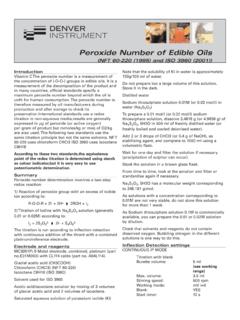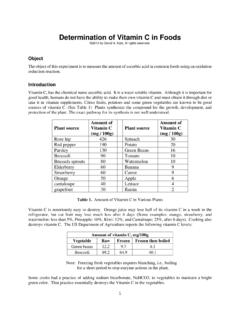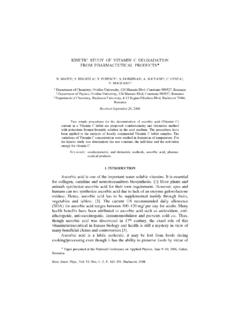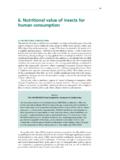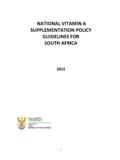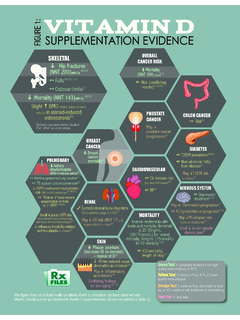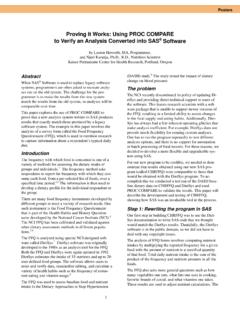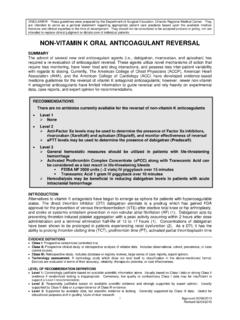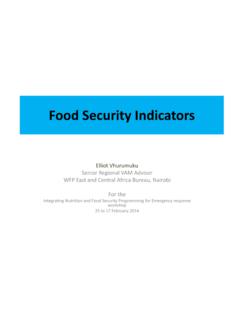Transcription of The World Health Organization is a specialized agency of ...
1 TheWorldHealthOrganizationisaspecialized agencyofthe thisorganization,whichwascreatedin1948,t hehealthprofessionsofsome190countries exchangetheirknowledgeand experiencewiththeaim ofmakingpossibletheattainmentby allcitizensoftheworldbytheyear2000of alevelofhealththatwill direct technical cooperationwithitsMemberStates, andbystimulatingsuchcooperationamongthem ,WHOpromotesthedevelopmentofcomprehensiv ehealthservices,thepreventionandcontrol ofdiseases,theimprovementofenvironmental conditions,thedevelopmentofhumanresource sforhealth,thecoordination anddevelopmentofbiomedicalandhealthservi cesresearch, , suchasdevelopingsystemsofprimaryhealthca re~thafreachthewholepopulationofMemberco untries, promotingthehealthofmothersandchildren;c ombatingmalnutrition;controllingmalariaa ndothercommunicablediseasesincludingtube rculosisandleprosy;coordinatingtheglobal strategyforthepreventionandcontrolofAIDS ;havingachievedtheeradicationofsmallpox, promotingmassimmunization againstanumberofotherpreventablediseases ;improvingmental Health ;providingsafewatersupplies; healththroughouttheworldalsodemandsinter nationalcooperationinsuchmattersasestabl ishinginternationalstandardsforbiologica lsubstances,pesticidesandpharmaceuticals ; formulatingenvironmentalhealthcriteria;r ecommendinginternafionalnonproprietaryna mesfordrugs;administeringtheInternationa lHealthRegulations; revisingtheInternationalStatisticalClass ificationofDiseasesandRelatedHealthProbl ems.
2 TheconcernsandprioritiesoftheOrganizatio nanditsMembersStates, HealthJohnsHopkinsUniversityBaltimore,MD ,USAW orldHealthOrganizationGeneva1995 Firstedit,on1978 Secondedition1982 Thirdedtion1994 Thet:rsteditionwasmadepossb/ethroughagra nt toHe/enKeller InternationalfromtheUnitedStatesAgencyfo rInternationalDevelopment(USAID)Thesecon d editionwaspreparedunder Cooperative AgreementAID/DSAN-CA-0267betweentheInter nationalCenterforEp1demio/ogicandPrevent iveOphthalmologyandtheOfficeofNutr tionUSA/vThethirdedd cnicassupportedby CooperatveAgreementDAN-0045-A-5094-OObet weenJohnsHopkinsUn vers tvandTheOfhceotNutritionUSA/vWHOL ibraryCatalogunginPublicationDataSommerA l1redVitaminAdeticiencyanditsconsequence safieldguidetodetectionandcontrolAlfredS ommer3rdedIVitamnAdeficiency2 Xerophthalmia3 GuidelinesISPN92415447783(NLMC lassificationWO110)
3 TheWorldHealthOrganizationwelcomesreques tstorpermissiontoreproduceortranslateits publicatonsinpartorinfullApplicationsand enquiriesshouldbeaddressedtotheOfficeofP ublications WorldHealthOrganizationGenevaSwitzerland ,whichwillbegladtoprovidethelatestinform ationonanychangesmadetothetextplansforne w editions,andreprintsandtranslationsalrea dyavailable WorldHealthOrganization1995 PublicationsOttheWorldHealthOrganization enjoycopyrightprotectioninaccordancewith theprovisionsotProtocol2otthe UniversalCopyrightConventionAllrightsres ervedThedesignationsemployedandthepresen tationofthematerialinthispublicationdono timplytheexpressionofany opinionwhatsoeveronthepartottheSecretari atoftheWorldHealthOrganizationconcerning thelegalstatusol anycountryterritorycityorareaorofitsauth oritiesorconcerningthedelimitationofitsf rontiersorboundariesThementionotspecific companiesorotspecificmanufacturers productsdoesnotimplythattheyareendorsedo rrecommendedbytheWorldHeattbOrganization inpreferencetoothersofasimilarnaturethat are notmentionedErrorsandomissionexcepted
4 Thenamesofproprietaryproductsaredistingu ishedbyinitialcapitallettersTheauthoralo neisresponsiblefortheviewsexpressedinthi spublicationrypese inindiaPriniedinEngiand94 ~cl_~aisciniiianIcisysiTwc_i~3 OCONTENTSP refaceCharacterizationandassessmentofthe problemPreliminaryassessmentDefinitive assessmentPrevalencesurveysClinicalparam etersBiochemical parametersDietaryparametersPreparatoryda taSamplesizeSelectionofsampleFormsAcknow ledgementsvuIntroduction1 VitaminAmetabolism3 VitaminAstatus6 Xerophthalmiaclinicalclassificationanddi agnosis8 XNNightblindness9X1A,X1 BConjunctivalxerosisandBitot sspot9X2 Cornealxerosis11X3A,X3 BCornealulceration/keratomalacia11 XSScars12 XFXerophthalmicfundus12 Epidemiology15 Age15 Sex16 Season16 Clustering17 Generalpatternofxerophthalmia17 Magnitudeanddistributionoftheproblem1819 19212222252627272830 PersonnelandfieldactivitiesDataanalysisI nterpretation313233 Treatment36 Xerophthalmia36 VitaminA36 Medicalstatusand diet37 Eyecare38 Preventingrecurrence38 Measlesandotherhigh-riskinfections39 Otherhigh-riskgroups39 Logistics40 Prevention41 Increasedintakeofdietarysourcesofvitamin A42 Periodicsupplementation43 Fortificationofdietaryitems46 Evaluation47 References49 Annexes1 Clinic-basedcase-reportingform542 Examiningeyesinthefield553 Collectingandhandlingbloodsamplesinthefi eld574 Xerophthalmiafieldsurveyforms59
5 Additionalreading66 IvPREFACEThe firsteditionofthis manualwaspublishedin1978underthetitleFie ldguide tothedetectionandcontrolofxerophthalmia, tomeettheneedforapracticalguide for usebyclinicians,nurses,andpublichealthof ficialsconcernedwithpreventingxerophthal miaThiswas inaccordwitharesolutionof the Twenty-fifthWorldHealthAssembly(1972),wh ichurged anintensificationofactivitiestopreventne edlesslossof sight from one ofthethree mostimportantcausesofpreventableblindnes sAsecondeditionof themanualwaspublishedin1982toreflectadva ncesinunderstandingoftheclinicalmanifest ations,pathogenesis,epidemiology,andtrea tmentofxerophthalmia(1),itincludedrevisi onstotheclinicalclassificationof the disease,prevalencecriteriaforestablishin gapublichealthproblem,andtreatmentrecomm endations(2)Since1982,newinformationhasi ncreasinglypointedtotheimportanceofvitam inA in thebroaderrealm ofchildhealthandsurvival(3 7)ThiswasrecognizedbytheThirty-seventh(1 984)andForty-fifth(1992)WorldHealthAssem blies,whichdirectedtheWorldHealthOrganiz ationto intensify its efforts tocontroltheimpactofvitaminA deficiency on childhealth,blindness,andsurvivalWithext ensionand furtherrefinementof thisknowledge,growingcommitmentbygovernm entstocontrol andeliminatetheproblemembodiednotablyint heWorldDeclarationontheSurvival,Protecti on andDevelopmentofChildren(8)
6 AndtheWorldDeclaration andPlanofActionforNutrition(9) andprogrammaticmomentumandleadershipprov idedbyWHOandUNICEF(10, 11),ithasagainbecomenecessarytoreviseand expandthe scope oftheoriginalmanualACKNOWLEDGEMENTST hanksareduetothemany individualswho haveofferedusefulsuggestionsandcommentso nallthreeeditionsofthis manualThisthirdeditionbenefitedinparticu larfrom thecontributionsofDr BarbaraUnderwood,scientistresponsiblefor micronutrients, andthe carefuleditingofMrJamesAkr ,technicalofficer,bothof theNutritionunitofWHO s DivisionofFoodandNutritionTheWorldHealth Organizationgratefully acknowledgesthefinancialsupportoftheMicr onutrientInitiativeforthe preparationof theFrench andSpanish editionsofthis publicationTheInitiativewasestablishedin 1992by itsprincipalsponsorstheInternationalDeve lopment ResearchCentre,the Canadian InternationalDevelopmentAgency.
7 TheWorldBank,theUnited NationsDevelopmentProgramme,andtheUnited NationsChildren sFundtocontributeto thesustainable controlofmicronutrientmalnutritionVIIINT RODUCTIONO cularmanifestationsofvitaminAdeficiency, particularlynightblindness,havebeenrecog nizedsinceantiquityAnimalresearchandclin icalobservations earlyinthetwentiethcenturyindicatedthatv itaminAwasimportantfornumerousbodilyfunc tionsanimalsandhumansdeficient invitaminA grewpoorly,sufferedmorepersistentorsever einfections,andsubsequentlydevelopedchar acteristicocular manifestationstermed xerophthalmia or dryeye VitaminA-deficientanimalsdiedprematurely ofoverwhelmingsepsis,usuallybeforedevelo pingxerophthalmiaInterest soonfocused on thereadilyapparent,anddevastating,ocular manifestationsofvitaminAdeficiencyBy theearly1940s,thesehadbeeneliminatedfrom wealthier countriesthroughavarietyofdietaryinterve ntionsSurveyssubsequently revealedthatvitaminAdeficiencyand xerophthalmiawerelargelylimited todevelopingcountries, especiallyinAfrica,Asia,andtheWesternPac ific,withisolatedfociintheCaribbean, Central andSouthAmerica,andtheEastern Mediterranean(1,2)
8 TheWorld HealthOrganizationnowclassifiescountries accordingto evidence ofsubclinicalaswellasclinicaldeficiencyi nallorpartoftheterritoryAccordingly,ther eare39countriesinwhichvitaminAdeficiency isaclinically significant publichealthproblem,and11countrieswhere, subclinically,itissufficientlyprevalenta ndsevereastoconstituteaseriouspublicheal thproblem,27countrieswherethisisthecasei natleast some regions,and18othercountrieswherethereisl ikelyto beaproblembutwheredataarelackingandcaref ulmonitoringiscalled forAtleast5 10million childrendevelopxerophthalmiaevery year, ofwhombetweenaquarterandhalfamilliongobl ind(12,13)Modernconceptsofxerophthalmiad ate fromtheearly1800s,whendogsthatwere starved onsugaranddistilledwaterdevelopedperfora tingcornealulcersresemblingthose in ill-nounshedinfants (14)Onehundredyearselapsedbeforeinvestig ators realizedthatthesechangeswerecausedbylack of aspecificnutrient(15 17) fatsolubleA ,presentin the lipidfractionof milk,eggs,butter,andcod-liveroil,andaspr ovitaminAcarotenoidsindark-green leafy vegetablesandcertaincolouredfruits Blocknotedthatvitamin-A-deficientchildre nwere farmorelikelytodevelopurinarytractinfect ions,andthatvitaminAtreatmentcuredthecon dition(18),andMellanbydubbed vitaminA the anti-infection vitamin (19)
9 Histopathologicalobservations soondemonstratedtheimportanceofvitaminA formaintenanceofnormalepithelialintegrit y(20),thus providingonepossibleexplanationforits role inVitaminAdeficiencyanditsconsequencesre sistanceto infectionMorerecently,ithasbeensuggested thatvitaminAalsoaffectsimmunecompetence( 2])Recentdataindicatethatmortalityratesa reincreasedamongchildrenwith mildvitaminAdeficiency(22)andthat,inmany areas,improvementinvitaminAstatuscan reduce the risk ofmortalityfromchildhoodinfectionsbyasmu chas19 54%(7,23 29)Thereductioninmortalitythatresultsfro mimprovementsinvitaminAstatusexceedswhat would be expectedsolelyfromreducingthenumbersofde athsassociatedwithxerophthalmia vitaminA deficiencyappearsto increasetherisk ofdeathevenbeforexerophthalmiaisclinical lyapparentVitaminAtherapyreducesthe severity ofcomplicationsandthemortalityratesassoc iatedwithmeasles(5,30 32),andimprovementincommunityvitaminAsta tusreduces thesubsequentrisk of measlesmortality(26,28,29)Thus, WHOandUNICEF recommendvitaminAsupplementationaspartof the casemanagementofmeasles inpopulations amongwhomvitaminAdeficiencyisknownto beaproblemormeaslescase-fatalityratesexc eed 1%(33)
10 Itisestimatedthatatleastonemillionchildd eathswouldbepreventedeachyearifvitaminAn utriturewereimproved(34)Theimpactofimpro vedvitaminAstatusonpreschool mortalityvariesfromone populationtoanotheranddependson a widevarietyoffactorsTheseincludeseverity andprevalenceofpre-existmgvitaminAdefici ency,concomitantnutritionaland relateddisorders,andthe type,intensity,andfrequencyofprevailingi nfectionsandrelatedfactors(7,24,35,36)2 VITAMINAMETABOLISMV itaminA,orretinol,isafat-solublesubstanc efoundinliver(particularlyfishliver)andi n eggyolkanddairyproductsCarotenoids potentialprovitaminAprecursors thatcan beconvertedtoretinolin the wall of the gut arepresentin greenleafy vegetables, red palmoil,yellow fruits,andthelikeTherelativebiologicalva luesof thesevarioussubstanc










